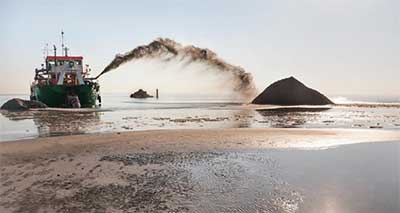Date : 08/09/2023
Relevance – GS Paper 3 – Environment
Keywords – Marine sand watch, UNEP, ISA, MMDR Act
Context –
In a recent development, the introduction of a fresh data platform named 'Marine Sand Watch' has brought attention to a pressing concern - the extensive removal of sand and its profound implications. This unceasing extraction of sand from the Earth's oceans is now recognized as a grave menace to both marine environments and coastal societies.
About Marine Sand Watch
Origin of the Platform: This data platform is a creation of the Center for Analytics, situated within the United Nations Environment Programme (UNEP).
Scope of Monitoring: The primary objective of this platform is to meticulously oversee and monitor the extraction of various materials, including sand, clay, silt, gravel, and rock, from marine environments worldwide.
Information Dissemination: It serves as a valuable source of data, offering insights into multiple facets, such as regions designated for sand extraction, zones engaged in both capital and maintenance dredging operations, prominent sand trading ports and hubs, the quantity of vessels and operators involved, and the documentation of sediment extraction and other related activities within countries possessing Exclusive Economic Zones (EEZs).
What Constitutes Marine Sand Extraction?
Overview:
Marine sand extraction refers to the procedure of sand removal from either the seabed or the coastal zone, serving diverse purposes like construction, land reclamation, beach enrichment, or mining.
Methods:
1. Dredging:
The most prevalent technique employed in marine sand extraction is dredging. This method entails the use of a vessel equipped with a suction pipe or mechanical grab to collect sand from the seabed. Subsequently, the gathered sand is transported either to the shoreline or an alternative location for various applications.
2. Mining:
An alternative method for marine sand extraction is mining. This approach necessitates specialized equipment, such as drills, cutters, or jets, to disintegrate sand deposits and extract valuable minerals or metals contained within them.
3. Harvesting:
Harvesting, though less common, represents another method of marine sand extraction. This technique harnesses natural forces like waves, currents, or tides to accumulate sand from the coastal zone and deposit it on the shoreline.
Quantifying Extraction:
According to estimations provided by the platform, an annual extraction of sand ranging from four to eight billion tonnes transpires from the ocean floor. Projections indicate that marine sand extraction is poised to escalate, potentially reaching 10 to 16 billion tonnes annually. This rate corresponds to the natural replenishment rate, which is essential for maintaining the structure and function of coastal and marine ecosystems, and the equilibrium rivers require.
Environmental Consequences of Marine Sand Extraction:
- Water Quality Disturbance: The process of sand extraction contributes to heightened water turbidity, reducing the clarity of water and adversely affecting aquatic ecosystems.
- Nutrient Disruption: Sand extraction disrupts nutrient availability, potentially jeopardizing marine flora and fauna.
- Noise Pollution: The extraction activities generate noise pollution, causing disturbance to marine organisms and their habitats.
Impact on Communities and Infrastructure:
- Coastal Community Vulnerability: Coastal communities are exposed to risks because sand is a critical component for constructing coastal defense structures, crucial for mitigating the effects of rising sea levels and storms.
- Infrastructure Development: Marine sand plays a pivotal role in constructing offshore infrastructure, including facilities like wind and wave turbines.
- Salinization Hazard: Extraction activities conducted in coastal or near-shore areas can lead to the salinization of aquifers, which may subsequently impact freshwater resources.
- Tourism Impediments: Sand extraction can impede the future development of tourism in coastal regions, thereby affecting local economies.
Responses to Address Marine Sand Extraction:
Sand Mining Regulations in India:
- Sand is categorized as a "minor mineral" under the Mines and Minerals (Development and Regulations) Act, 1957 (MMDR Act), with administrative authority over minor minerals vested in State Governments.
- Given that rivers and coastal regions are primary sand sources, there has been a significant surge in demand due to the country's construction and infrastructure development boom.
- The Ministry of Environment, Forests, and Climate Change (MoEFCC) introduced "Sustainable Sand Mining Management Guidelines 2016" to encourage environmentally conscious and scientifically managed sand mining practices.
Global Efforts:
- Several countries, including Indonesia, Thailand, Malaysia, Vietnam, and Cambodia, have imposed bans on marine sand exports over the last two decades.
UNEP Recommendations:
- The United Nations Environment Programme (UNEP) advocates for enhanced monitoring of sand extraction and usage.
- UNEP calls for the establishment of international standards governing sand extraction within marine environments.
International Seabed Authority (ISA):
- The ISA is an intergovernmental organization responsible for regulating deep-sea mining and exploration in international waters.
- Established in 1982 under the United Nations Convention on the Law of the Sea (UNCLOS).
The Way Forward:
- Progress necessitates increased innovation and investment in sustainable alternatives to marine sand extraction. This encompasses the reduction of sand demand through the adoption of superior construction materials, recycling practices, and the principles of a circular economy.
- Exploring alternative sources of sand, including manufactured sand derived from crushed rock or quarry dust, as well as natural sources like desert or volcanic sand, is essential.
- Effective governance and regulation of marine sand extraction are pivotal, involving the establishment of well-defined standards for environmental assessments, licensing, reporting, and auditing.
- While the UNEP Marine Sand Watch initiative marks a positive stride, achieving comprehensive data and policymaking improvements calls for greater cooperation and support from all stakeholders.
Probable Questions for Mains Examination –
- Assess the environmental and socio-economic impacts of marine sand extraction and propose effective strategies for sustainable management of this resource. (10 marks, 150 words)
- Explain the role of international organizations like the United Nations Environment Programme (UNEP) and the International Seabed Authority (ISA) in addressing the challenges posed by marine sand extraction. How can global cooperation be strengthened to regulate and mitigate the adverse effects of sand extraction on marine ecosystems? (15 marks, 250 words)
Source – Down to Earth, PIB








